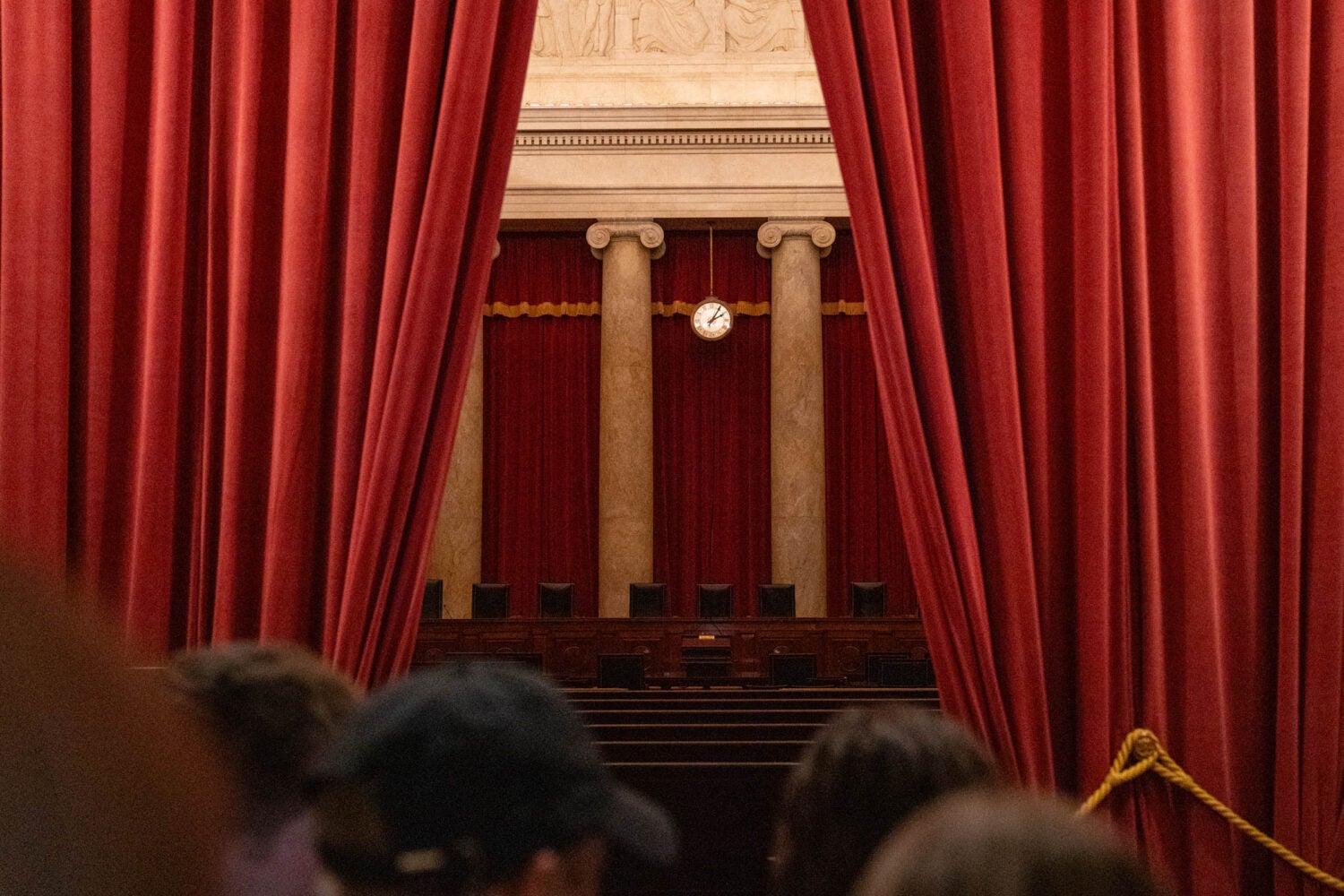Is the United States Supreme Court set to have a relatively quiet session? Don’t count on it.
After several highly active — and critics might say “activist” — years punctuated by landmark decisions involving abortion rights, the administrative state, affirmative action, presidential immunity, the Second Amendment, and more, the list of cases currently on the docket for the new term, which begins on October 7, appears to contain only a few likely to garner similar levels of interest from the general public.
But Mark Tushnet, the William Nelson Cromwell Professor of Law, Emeritus at Harvard Law School, believes that perception could be short-lived. “At the moment, it’s a low-profile docket. But that’s going to change.”
Tushnet, an expert in constitutional law, says that litigation is nearly certain to ensue after the presidential election on November 5. “There’s no question about that, and that’s going to be high profile,” he adds.
In an interview with Harvard Law Today, Tushnet, who also served as a law clerk to Justice Thurgood Marshall, shared his view on some of the most noteworthy trends affecting the current Court, including whether its reputation for hearing contentious cases will continue into its 2024-25 calendar.
Beyond his predictions for a not-entirely-tame Supreme Court term, Tushnet also discussed the shrinking number of cases slated for review, the increased use of the emergency, or “shadow,” docket, and why the Court is likely to continue to remain “aggressive” in its conservatism for the foreseeable future.

Harvard Law Today: In the past few years, we have seen many hot button issues being addressed by the Court. Yet, with a few exceptions, I wonder if this term’s cases seem less controversial to you. If so, could that be strategic?
Mark Tushnet: They granted review on about half the cases they’re going to eventually decide, and only two or three of them so far are likely to get significant attention individually. At the moment, it’s a low-profile docket. But that’s going to change. First of all, there’s going to be litigation around the election. There’s no question about that, and that’s going to be high profile. Much of that will be on the emergency docket because those cases must be decided before January 20.
Who knows what else will come before the Court that’s going to turn out to be controversial beyond that? Emergency docket [otherwise called the “shadow docket”] opinions can affect this, because the Court can take them off the emergency docket and place them on the regular docket, as they did in a couple of cases last year.
I would also note that there is this weird phenomenon, a pattern, of the Court being “active,” high profile, attracting criticism in Congress, and for reasons that nobody can explain, the Court lowers its profile next term. We may be seeing that pattern.
HLT: The number of cases decided by the Supreme Court each term has fluctuated throughout its history. In recent years, the Court has had a relatively small docket, at least compared to, say, the 1980s. Why might this be, and what impact does that have on our overall system?
Tushnet: I don’t think anybody really has come up with a cogent explanation for the quite dramatic reduction in the size of the Court’s docket. I think the best explanation is jurisprudential. That is, the justices appear to think that getting the best outcome, however you define that, takes much more analytic work by them and their staffs, than justices thought four or five decades ago.
If you’re devoting more time to each case, you’re going to have to cut down on the number of cases you take. When I clerked in 1972-73 — 50 years ago — we had three times as many cases as the Court currently does. It was a lot of work, and you had to process the cases fairly quickly to get through them. I think we did a pretty good job. But if you think that you need to devote more time to each case than the justices did 50 years ago, then you’re going to have to cut down on the size of the docket.
HLT: Have the Court’s opinions been getting longer? And, if so, why might that be?
Tushnet: It’s pretty clear that they have gotten longer. There are studies that show that the average length of opinion and the number of opinions per case have gone up. My view is that that’s because they have fewer cases and more law clerks. This is the idea that work expands to fill the time available. If you’ve got four law clerks — unlike when I was working, when there were three — you have more labor to use on those cases, and you have to fill their time, so you do that by writing longer opinions.
HLT: You mentioned the emergency docket. What, exactly, is it? And is it being used more frequently now?
Tushnet: There has always been an emergency docket, but it is being used more recently. What’s happened is that aggressive state attorneys general — mostly Republican, but some Democratic — have filed lawsuits in lower federal courts against significant federal programs. Examples include Donald Trump’s “Muslim ban,” or Biden’s pandemic restrictions.
They get a decision from the lower court. If the program is enjoined [or placed on hold until the lawsuit is decided], the national government says, “We have got to get this resolved fast.” If it’s not enjoined, state attorneys general say, “This is an outrageous violation of the law that’s going to cause a lot of harm, so we got to get the case resolved fast.” In either situation, they want to go to the Supreme Court quickly, before the case is resolved in the lower federal courts, in order to get what is nominally temporary or interim relief. That is, the Court will stay the injunction so that the program can go into effect or will uphold an injunction so that it doesn’t.
In general, it is an emergency docket, and ‘emergency’ means that they’re supposed to decide the cases pretty quickly. That means they decide the cases with relatively less information than they would otherwise have. And contrary to what’s happening on the regular docket, where cases are taking longer to decide and writing longer opinions, on the emergency docket, you get short opinions that are sometimes a little sloppy. Nominally, these decisions are temporary. But what’s happened is that the emergency docket opinions have now tended to be treated by lower courts as the equivalent of full-scale precedents by the Supreme Court.
HLT: Another thing we have heard some experts worry about is the use (or abuse) of national injunctions, which can halt administrative action across the entire country while a lawsuit is litigated. How has the current Court treated such injunctions?
Tushnet: The best answer is that justices mutter in their opinions that these are a bad idea, that they’re not fully authorized by the relevant statutes, that judgments should be more narrowly designed. They mutter about this, but in fact, they have done nothing significant to cut back on the availability of these nationwide injunctions. That’s because sometimes conservatives like nationwide injunctions against liberal policies, like those of the Biden administration, and sometimes liberals like nationwide injunctions against conservative policies, like those of the Trump administration. So, although the justices express dismay about them, their interest in deciding the merits of the cases has outweighed their interest in reining in this practice.
HLT: There have been a few significant “leaks” out of the Supreme Court in recent years. Some notable ones include the release of an early version of the Dobbs opinion in 2022, and documents that formed the basis of a New York Times article about Chief Justice Roberts’ thinking on the presidential immunity case. Is there historical precedent for these kinds of unauthorized disclosures from the Court?
Tushnet: There were leaks in the past, but these ones you refer to are different in kind, because the prior leaks were about results. Prior leaks were essentially just, the Court has decided and is about to announce X. That was always regarded as bad, but it happened — just not often. It’s not clear that the rate of leaks is higher now, but the nature is quite different, because I don’t know of any other leaks of opinions, or leaks in the short run of details about internal workings.
Why has it happened? Partly, it is the higher political profile of these cases. Partly, it is that you simply have more people who have access to the opinions, and so, the chance that somebody is going to violate the rules against outside disclosure just goes up.
I also want to note another factor here, which is that some journalists have decided to treat the Supreme Court as a political beat. That is, just as it’s the job of their colleagues who cover Congress to find out what’s going on behind the scenes, they think it’s their job, as people who cover the Supreme Court, to find out what’s going on behind the scenes there. That’s different from what happened in the past, where reporters tried to find things out but were very protective of the institution. Once you have more people with access to information inside the Court, and now more people probing to find out what’s happening, the chances of information getting out go up.
HLT: Are there any other trends you’ve noticed about the Court in recent years?
Tushnet: The main trend is that if you have a 6-3 conservative majority, it’s much easier to be aggressive in your conservatism than if you have a 5-4 majority, because with a 5-4 majority there’s always a risk that somebody will say, “Wait a minute, we’re going too far.” With 6-3, it doesn’t matter so much. You could see that last year in some of the cases — the presidential immunity case being the primary example. With a 6-3 majority, the trend is going to be to have conservative opinions fairly regularly, with extremely rare decisions coming out in a more liberal direction.
Want to stay up to date with Harvard Law Today? Sign up for our weekly newsletter.
